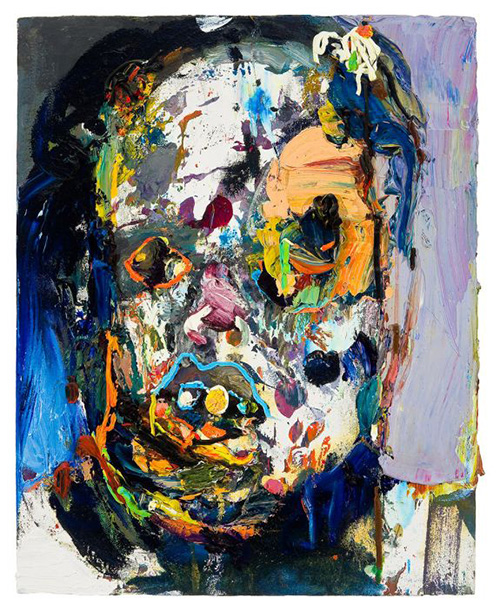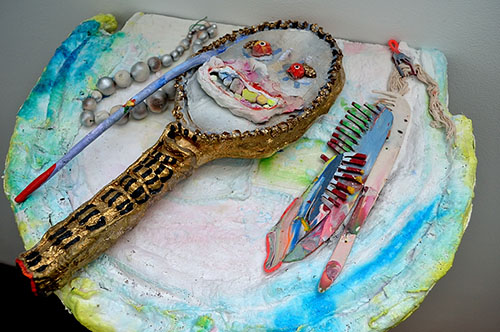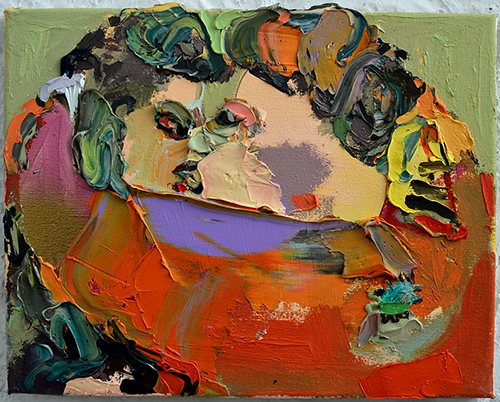A few weeks ago, artist Summer Wheat invited me to her studio near the border of Bushwick and Ridgewood to a spot where Brooklyn uncomfortably abuts Queens. From the over-sized industrial windows in Wheat’s studio, a sunset panorama of Manhattan was tinged magenta. The vibe inside Wheat’s studio was likewise colorful: bold, tactile paintings were scattered about the walls and the tables were littered with pre-mixed monochromatic palettes, Tupperware containers of muddy hues, soiled latex gloves, and cake decorator nibs filled with pungent oil paints. Wheat herself had worn subdued tones, tawny browns and earthy olives, layering abstract floral prints over opaque navy tights. We sat at a table that had been set for the occasion with a bottle of white wine and a spread of snacks. Over the next two hours, Wheat, nibbling and sipping occasionally, talked openly about her work and life.
A native of Oklahoma, Wheat blushed faintly as she recounted her “wholesome” childhood in the suburbs of Oklahoma City. She described her hometown’s mishmash of Native American mysticism and Western Americana as otherworldly, densely populated with “cowboy space gangsters.” Wheat was a different breed of alien, though she was not alone. There were other like-minded oddballs, including her grandparents, who decorated their home exclusively with green furniture and cruised the town in a canary yellow convertible. Exotic gifts from their travels around Asia aroused her curiosity about the world beyond the Midwestern state. From a young age Wheat was keen to leave.

Summer Wheat. “Missing Mandible Melvin,” 2010. Acrylic and oil on canvas. 16 x 20 in. Courtesy the artist.
At eighteen Wheat headed eastward to Georgia to embark on her studies as the Savannah College of Art and Design (SCAD). Wheat eventually finished her college degree several years later, in 2001, at the University of Central Oklahoma, spacing out her schooling to shuffle around this country and nine others for nearly a decade. All the while she stayed active by sketching and writing on the road.
In 2003, Wheat found herself in Savannah again, this time as a graduate student at SCAD. As an MFA candidate, she began a series of detailed scroll drawings on cash register receipt tapes. Contrary to the aggressive pace of Wheat’s more recent paintings, these drawings were intimately cast with delicate nets of fine lines. Unfortunately, the body of work created for her graduate thesis show, the culmination of two painstaking years, was destroyed. Suffice it to say that the destruction of these drawings had an indelible impact on her career.
In the wake of this loss, Wheat set about resurrecting the ruined work. She stayed secluded in her Savannah studio for five years. No one saw the work in her studio and the work saw no one outside. The singular goal of this self-imposed isolation was to tune into her inner artist. After a few years, some friends who had opened a gallery in the area offered her a show on a whim. Wheat accepted. To her surprise, the work came easily. Yet the show bombed—badly—and she made a resolution the night of her opening to move to New York City.
Wheat arrived in New York two years later in 2009. She scrounged, couch surfed, and worked a laundry list of jobs. In 2010, she landed a residency with the Triangle Arts Association in DUMBO, a fortuitous move to which much of her recent success is owed. During her year at Triangle (a residency normally awarded for three-months) Wheat met a dealer from the gallery that now represents her—Samsøn Projects in Boston—and was given a booth at the Volta NY art fair the following year, and a solo show in their space in 2012. Shows at the deCordova Sculpture Park and Museum, the Torrance Art Museum, and Thierry Goldberg Gallery followed.

Summer Wheat. “Put on a Happy Face,” 2012. Plaster, sculpy, ink and oil paint on shelf. Dimensions vary. Courtesy the artist.
During this time, Wheat has been cultivating bodies of thematic content. For example, she made a series of paintings based on historical images of zombies and more broadly, she created a body of work about love for a show, entitled It was the Best of Times at Valentine Gallery in Ridgewood, Queens last October. The paintings and sculptures for this show were inspired by the story of a former co-worker in Georgia, who would set her alarm for a quarter to four every morning when her husband would return from his second factory job. Before drawing the water for his diurnal bath, she would wrap his feet in hot towels. Outmoded gender roles notwithstanding, Wheat was struck by these ongoing gestures of near extinct, devotional love. Persistent, small sacrifices such as these mirror the imperceptible toils that connect an artist to her discipline, and more importantly, one person to another.
Given the context, the documentation of work in the Valentine show pertains to the daily maintenance of personhood—that is, grooming. Inverting the art historical formula of female bathers painted by male artists such as Bonnard and Picasso, Wheat made several large paintings of male bathers as well as objects like mirrors, toothbrushes, and combs sculpted out of paint. Tension arises when the palpable delight of the work’s execution confronts the grotesque rendering of the forms as in Kiss (below). In this painting the squishy embrace of two massive heads is memorably depicted, subject matter matching the heft of the haptic aspects of the work. Wheat gropes touchy subjects as the materials and forms are raucously upended.
Lately, Wheat has been catching her breath. Recalling a recent stroll around Brooklyn, she compared the bustling streets of Williamsburg to a Bruegel painting: there was a burrito guy (perhaps the modern equivalent of the pie man), a cheese shop, and a place to buy bread. It occurred to Wheat that people have not changed much since the sixteenth century, or at least, she’s more attuned to the ways people remain the same. The gross shapes of society, its people and their juicy innards will continue to feed her work.
Summer Wheat (b. Oklahoma City, 1977) currently lives and works in Brooklyn, NY. She holds an MFA from the Savannah College of Art and Design, Savannah, GA.







Pingback: APRIL 12TH, 2013 - Studio Beat